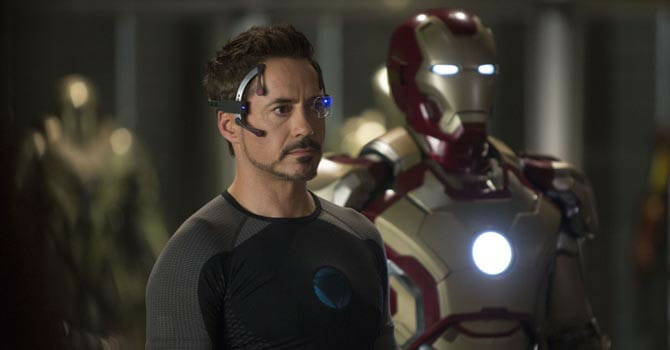Iron Man 3

For any fan of superhero films, there were a few reasons to view Marvel’s latest installment in the Iron Man movie franchise with a degree of trepidation. On one hand, there was the early word that the Mandarin, the closest thing Iron Man has to a true arch-villain, would lack the main quality that made him a dangerous foe to Shellhead. (No, I’m not referring to the inescapably racist overtones of the character’s initial creation.) Besides being an athletically gifted criminal mastermind—pretty standard fare for villains, all things considered—the Mandarin had his rings. Looted from an alien spaceship, each of his ten rings possessed a separate power, any one of which would serve just fine for a young super villain wishing to make his or her way in the world. (Dibs on the disintegration ray!) Taken together? You had a foe who could meet a super-intelligent playboy billionaire encased in a flying, armored battlestation on equal footing. The rings added that extra level of threat needed to put the arch in “arch-villain.” (There’s a reason Doctor Doom, and not Paste-Pot Pete, is the arch-nemesis of the Fantastic Four.) But more troublingly, news of such a move reeked of the bad ol’ days when, either for budgetary reasons or a studio head just not getting it, a hero’s entire rogues’ gallery was ignored and replaced by the dreaded “evil scientist” (or worse, a gamma-irradiated poodle).
And then there’s the track record of superhero trilogies in general. In the relatively young history of super franchises, third entries have been dependably unimpressive. Spider-Man 3 proved a bit of a mess. Superman 3 and X-Men 3: The Last Stand stunk. Sandwiched in between Tim Burton’s first two efforts and the horror that would become known as Batman and Robin, Batman Forever is more useful as a cautionary tale than solid entry. (“But Daddy, why didn’t someone stop Schumacher before he made a fourth film?”) Only Christopher Nolan’s recent trilogy capper, The Dark Knight Rises, proved worthy of its franchise. (And few would argue it was better than its predecessor.)
And frankly, had I known beforehand that such a large portion of Iron Man 3 would involve an unarmored Tony Stark, I’d have been even more skeptical. That’s like hearing that two-thirds of the next Superman film will just be a resourceful Clark Kent “getting by as best he can.” It’s not that such tales are never told or never any good. As a change of pace in a 500-plus issue run, they can be great. But one can see what normal humans (even movie stars!) look like all the time. Just as one goes to Jurassic Park to see the dinosaurs, one goes to a superhero film to see the super-powered folk being all super heroic—and super villainous.
Yet, despite the trepidation, Iron Man 3 works, providing just the right mix of action (much of it explosive), chuckles (mostly via banter) and plot (fairly comprehensible). Some of that credit goes to director Shane Black, no stranger to the action genre as a screenwriter (Lethal Weapon, The Last Action Hero), nor to Robert Downey Jr. as a director (Kiss Kiss Bang Bang). With Whedon’s Avengers still looming large in the rearview mirror (and providing much of the impetus for Tony Stark’s personal character arc in Iron Man 3), Black keeps the plot and pacing under much firmer control than Jon Favreau did in Iron Man 2.